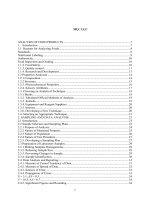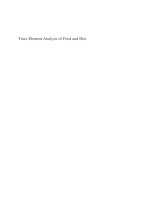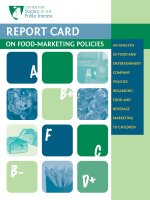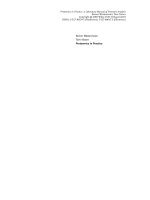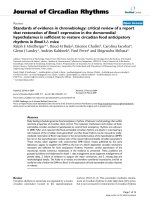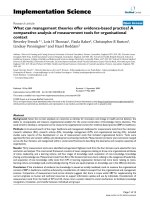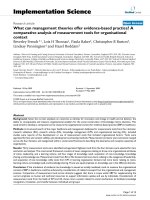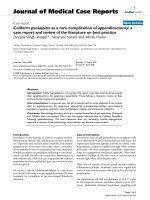experimental report subject practice of food analysis
Bạn đang xem bản rút gọn của tài liệu. Xem và tải ngay bản đầy đủ của tài liệu tại đây (738.41 KB, 52 trang )
<span class="text_page_counter">Trang 1</span><div class="page_container" data-page="1">
EXPERIMENTAL REPORT Instructer: Dr. Nguyen Vinh Tien
Subject: Practice of food analysisID Class: PRFA414550E_22_2_05FIE
Group: 03
</div><span class="text_page_counter">Trang 2</span><div class="page_container" data-page="2">Assessment of Accuracy and Precision
1. Introduction
Determine the deviation/error of mass (analytical balance) or volumetric instrument(burette, pipette, micropipette, volumetric flask, beaker). From there determine the errorrange of the instrument in the experiment, estimate the error of the experimental results.Thereby making comments and comparing the deviations between supplies
- Volumetric flask, 100ml- Micropipette
- 1 pipette 1ml- 1 pipette 10ml- Rubber bulb- Standard weight- Analytical balances- Precision balances
</div><span class="text_page_counter">Trang 3</span><div class="page_container" data-page="3">5. Procedure
5.1: Evaluate the error of the pipette1.Put the 100mL beaker on the analytical balance
2.Press Tare to not calculate the beaker weight, reduce to the value 0.00g
3.Use a 100mL pipette to accurately draw 100mL of distilled water into the beaker placed on the balance
4.Weigh the volume of water added
Note: It is not necessary to pour the water from the previous measurement out of the cup, just press Tare and then take another 1mL of water.
(Do the same with the 1mL Pipette)Repeat the experiment 6 times 5.2: Evaluate the error of the buret
1.Place the 100mL or 20mL beaker on a precision balance
2.Press Tare to subtract the cup weight, reducing it to a value of 0.00g.3.Using a burette (25/50ml) add 10ml of distilled water (ml) to the beaker.
4.Drain 10 mL from the burette in turn until the amount of water in the burette is not enough 10 mL, then add water and adjust to zero.
5.Repeat until 6 measurements are obtained.
Then repeat the process as above but take 1 mL from the burette.5.3: Evaluate the error of the micropipette
1.Place the 100mL or 20mL beaker on a precision balance
2.Press Tare to subtract the cup weight, reducing it to a value of 0.00g. 3.Using a 1000 µL micropipette add 1ml of distilled water (ml) to the beaker. 4.Weigh the volume of water added
Repeat this process 6 times.
Note: It is not necessary to pour the water from the previous measurement out of the cup, just
</div><span class="text_page_counter">Trang 4</span><div class="page_container" data-page="4">press Tare and then take another 1mL of water.
5.4:Total amount of water and amount of water taken from the volumetric flask1.Place the 100ml/Beaker 100ml volumetric flask on the precision balance
2.Press tare to subtract the cup weight, convert to the value 0.00g
3.Fill the flask up to the mark with water and weigh the amount of water in it.
4.Then tare a 100 mL beaker and pour water from the upper volumetric flask into the beaker, weighing the amount of water removed from the flask
Repeat this process 6 times.
5.5: Accuracy of measurements from balance1.Press the balance tare to return to the 0.00g value.
2.Put weights 50g, 100g, 200g respectively on a precision balance.Record the result
Note:Do not touch the weight with bare hands to avoid the oils from sweat sticking the weight.Work with precision balances and analytical balances. Then record the number of the balances
6. Calculation and results
6.1:Evaluation of pipette error
e
</div><span class="text_page_counter">Trang 5</span><div class="page_container" data-page="5">0.9986 0,01±29
9,9292 0,04±24n=6
9,9998 0,00±62
9,9230 0,01±56
6.2:Evaluation of Buret 25ml error
10ml
</div><span class="text_page_counter">Trang 6</span><div class="page_container" data-page="6">0.9866 0,06±26
9,95 0,0655±n=6
24
</div><span class="text_page_counter">Trang 7</span><div class="page_container" data-page="7">6.3
:Evaluation of micropipette error
0,9866 0,01±44n=6
Mean
</div><span class="text_page_counter">Trang 8</span><div class="page_container" data-page="8">6.4:Total amount of water and amount of water taken from the volumetric flask
Mass in analytical balances(g)
Errors may appear due to: Instruments are relative, misaligned, chipped, sweaty hands...
</div><span class="text_page_counter">Trang 9</span><div class="page_container" data-page="9">When taking water into the cup and weighing it, there may be some water left on the wall of the machine
The person conducting the experiment did not perform the operation correctlyDue to laboratory conditions such as when the balance meets the wind, it will affect the weighing results.
Because there are computational differences between the data, it is necessary to perform many times to obtain a set of values around the true value, minimizing errors.
In addition, it is necessary to limit some human factors and surrounding factors when conducting experiments
8. Questions
1.In theory, how the standard deviation, coefficient vvariation, mean, relative error, and 95% confidence intervals are affected by: (1) multiple replicates and (2) measurements. bigger? When measured with pipettes and burettes, is this reflected in the results of experiments with n = 3 vs. n = 6, with 1 mL vs 10 mL?
In general, the standard deviation, coefficient variation, mean, relative error, and 95% confidence interval will be less than or equal to when the experiment is repeated many times, thereby reducing the difference between the samples. calculated value. This is also shown by thedata obtained during the experiment when calculating the values with n = 3 and n = 6.
2.Why should relative error and coefficient variation be used to compare the accuracy andprecision of the 1 mL and 10 mL volumes obtained from the pipette and burette in sections2 and 3, instead of just taking the average value? and standard deviation?
Instead of just the mean and standard deviation, we use the relative error and the coefficient of variation to compare the accuracy and precision of the 1mL and 10mL volumes taken from the pipette and the burette. for the coefficient of variation, which is more reliable, in addition to showing more clearly the range of errors between the values, the coefficient of variation also helps to gather data in a region and the acceptability of the obtained value.
4.If the accuracy and/or precision of the micropipette is lower than expected, what can be done to improve these characteristics?
Pre-wash the tip: Pre-wash the tip to ensure that all internal components are in contact with the
</div><span class="text_page_counter">Trang 10</span><div class="page_container" data-page="10">solution. Aspirate the sample into the tip and then back-flush or flush the waste cup to rinse the tip, increasing the accuracy of the pipetting process.
Reverse pipetting technique: This technique is used when aspirating viscous solutions (blood samples, ..) or volatile solvents. This technique also allows aspiration of microscopic volumes such as 0.5 µl or less. The reverse pipetting technique begins with pressing the plunger down to the stop position 2nd, thus including an additional volume remaining during sample aspiration, not included in the final discharge.
Consider ambient temperature: People or companies often align pipettes at room temperature,so if you use a pipette at a different temperature (e.g. in a cold room), you may not get the correct volume. corpse.
Consider sample temperature: When continuously aspirating samples at cold temperatures, the volume of solution at the first flush is always greater than the volume aspirated, but not on subsequent aspiration with the same tip. for exact volume. Therefore, it is recommended to rinsethe first aspiration into the solution tube and start aspirating from the second time.
Use volume-matched micropipettes: Micropipette accuracy will decrease when the discharge volume is close to the smallest volume the pipette can handle.
Install the pipette:
Adjust more than 1/3 of the turn to the desired volume. Then adjust back to the required volume.Do the same with different volumes, with different times
5. In a titration experiment with a burette, should the stopping volume be too much less than 10 mL? Is it better to use 10 mL burette or 50 mL burette for accuracy and precision?Why?
The stop-point volume should not be too much less than 10mL because the opening of the off valve is unstable, which can lead to errors in titration or reading. Using a 10 mL burette offers greater accuracy and precision. Because the smaller the error of the device, the higher the accuracy and precision. Where the 10 mL burette has an error of ±0.02 (mL), while the 50 mL burette has an error of 0.05(mL).
shut-6. Is the volume indicated on the volumetric flask a “take in” or “take out” volume? What does the volume on the pipette indicate?
The volume of each volumetric flask is the volume contained to exactly a given volume. The volume indicated on the pipette is the volume aspirated to an exact volume within a given
</div><span class="text_page_counter">Trang 11</span><div class="page_container" data-page="11">Test and calibrate measuring devices and instruments.
</div><span class="text_page_counter">Trang 12</span><div class="page_container" data-page="12">Determination of Moisture & Ash Content
1. Introduction
In the production and preservation of food, moisture, also known as total solids, is acrucial quality criterion. A uniform basis (on a dry matter basis) calculation of the contentof the other components also requires the estimate of moisture. The term "total solids" isfrequently used to describe the dry material that is left behind after the moisture analysis.It is still necessary to estimate moisture content in order to compute the totalcarbohydrate content even though it is not indicated on food package labels. Numerousmethods exist for measuring moisture content, however, it is frequently challenging to
</div><span class="text_page_counter">Trang 39</span><div class="page_container" data-page="39">Determination of reducing sugar by colorimetricspectrophotometric method with DNS reagents
1. Introduction
The spectroscopic method is based on the changes of electromagnetic radiation asit interacts with matter. When monochromatic light passes through a transparentcolored solution, its intensity is reduced, depending on its nature. and soluteconcentration in solution. In a given concentration range, this decrease (moreprecisely the log of the decrease in intensity, or optical density of the solution) isproportional to the concentration of the solute causing the color. That is the basisof the Beer - Lambert law that helps determine the concentration of solutes in asolution.
This method is based on the chromogenic reaction between reducing sugars and DNS reagents.
The color intensity of the resulting compound will be determined using a UV-Vis spectrophotometer and converted to a numerical value. The color intensity value of
</div><span class="text_page_counter">Trang 40</span><div class="page_container" data-page="40">the compound formed is proportional to the concentration of reducing sugars within a certain range.
Based on the standard curve equation will determine the reducing sugar content of the test sample.
4. Chemicals, supplies and equipmentsChemicals & food sample
<small>●</small> DNS reagents included:
<small>★</small> Distilled water: 60 – 70mL
<small>★</small> Solid NaOH: 1.6g
<small>★</small> DNS (C<small>7H4N2O7</small>): 1g
<small>★</small> (KNaC<small>4H O44</small>.4H<small>2O) salt: 30g</small>
<small>➔</small> Stir the mixture completely with a magnetic stirrer and make up to the 100mL mark with a volumetric flask. Reagents are stored at low temperature of 2 – 8oC and without light (solution is good for 10-15 days after reconstitution).
<small>●</small> Standard Glucose solution 0.1%<small>●</small> Distilled water
<small>●</small> Coca & pepsi
EquipmentsTest tubes
</div><span class="text_page_counter">Trang 41</span><div class="page_container" data-page="41"><small>●</small> Becher 100mL, 250 mL<small>●</small> Distilled water sprayer<small>●</small> Pipette 1mL, 2mL and 5mL<small>●</small> Glass funnel
<small>●</small> 100mL volumetric flask<small>●</small> Stirring Chopsticks<small>●</small> Cuvet
<small>●</small> UV-VIS colorimetric spectrophotometer
Sample 2(Pepsi_dilluted
500 mL)Standard Glucose
-Sample solution(mL)
</div><span class="text_page_counter">Trang 42</span><div class="page_container" data-page="42">Block diagram 5.1 How to Determination of reducing sugar by colorimetricspectrophotometric method with DNS reagents
6. Results and Calculation 6.1 Results
(Coca_dilluted100 mL)
Sample 2(Pepsi_dilluted
100 mL)Standard Glucose
-Sample solution(mL)
</div><span class="text_page_counter">Trang 43</span><div class="page_container" data-page="43">When measured on a 540 nm spectrophotometer:- Sample 1 (Coca): 0.243
- Sample 2 (Pepsi): 0.187 *Coke
➔ There is 6.875 g/100 mL of reducing sugar in the coke sample
Based on the 100ml nutritional value table in a coke bottle. The amount of sugar in 100 mL of coke is 10.6g.
The amount of reducing sugar in the total carbohydrates in coke is:% Reducing sugar = x 100 = 64.858%
</div><span class="text_page_counter">Trang 44</span><div class="page_container" data-page="44">➔ There is 5.284 g/100 mL of reducing sugar in the Pepsi sample
Based on the 100ml nutritional value table in a Pepsi bottle. The amount of sugar in 100 mL of Pepsi is 10.7g.
The amount of reducing sugar in the total carbohydrates in Pepsi is:% Reducing sugar = x 100 = 49.383%
7. Discussion
- Based on the data and graphs obtained from the experiment, we see that when theconcentration of the standard solution (specifically 0.1% glucose solution) increases,the absorbance of the solution also increases in order from the test tube 1 to 5.- The correlation coefficient R = 0.9827 is close to 1, so the experimental values havelittle difference compared to the standard curve.
The cause of the error- Incorrect sample dilution
- Prepare chemicals for non-standard experiments- Incorrect chemical collection
- Cuvet is scratched, dirty, so it affects the measurement result- The operation is not standard
Methods of minimizing errors- Accurate sampling
- Check and clean tools before taking chemicals and doing experiments- Performed under more secure experimental conditions
- Make sure cuvettes are clean and not scratched
</div><span class="text_page_counter">Trang 45</span><div class="page_container" data-page="45">- Repeat the experiment many times to come to the most accurate conclusion- When turned on, it is recommended to wait 10-15 minutes for the spectrometer to stabilize before testing
Determination of solution protein by Biuret method
1. Introduction
The sample of solid or liquid food contains a certain amount of soluble and insoluble protein. Besides that, samples of food also contain a certain amount of non-protein impurities that contain nitrogen, which is calculated by using Kjeldahl or Dumas method.
2. Objective
However, the compound contains non-protein nitrogen due to no peptide circuit so it doesnot create complexes with Cu2+ ions. Therefore, calculating protein concentration will becorrect when determined by creating complexes with Cu2+ indicator. And Biuret method is one of the methods that help identifying soluble protein in food based on its ability in creating the complexes of peptide circuits with Cu2+ ions.
3. Principle
The Biuret method is based on the complexification of Cu2+ to functional groups in the protein’s peptide bonds. The formation of a Cu2+ protein complex requires two peptide bonds and produces a violet-colored chelate product which is measured by absorption spectroscopy at 540 nm. Over a given concentration range, the measured absorption at 540 nm is linear with respect to the concentration of total protein. This relationship will allow us to create a standard curve that is used to calculate the concentration of an unknown sample.
</div><span class="text_page_counter">Trang 46</span><div class="page_container" data-page="46">4. Chemicals, supplies, and equipmentsa) Supplies and equipment:
- Test tube- Beaker 500ml- Volumetric flask 250ml - Micropipette
- Vortex
- UV-vis spectrophotometerb) Chemicals:
- Peptone- Gelatine- CuSO4. 5H O<small>2</small>
- NaKC4H O<small>46.4 H O (NatriKali tartrate)2</small>- NaOH
5. Procedure
5.1. Prepare biuret reagent
Figure 5.1. Diagram prepare biuret reagent5.2. Prepare standard protein solutions
</div><span class="text_page_counter">Trang 47</span><div class="page_container" data-page="47">5.3. Build standard curve
Emission at540nm
</div><span class="text_page_counter">Trang 48</span><div class="page_container" data-page="48">10 0.292
5.3. Determine the absorbance of food samples
6. Data and calculation
The emission of Peptone solution is 0.113 nm
Following the equation from standard curve, we have concentration of protein in peptone solution:
</div><span class="text_page_counter">Trang 49</span><div class="page_container" data-page="49">7. Discussion
Through this experiment, we can see the concentration of soluble protein in peptone solution is 3.396mg/ml
a/ The cause of the error
- The sample weighing may not be entirely accurate due to external environmental factors or insufficiently clean sample preparation equipment.
- The cuvette may not have been thoroughly cleaned, or there may be residues during handling and transportation.
- The storage of the Biuret reagent is not strictly controlled.b/ The solution
- Minimising the affection of surrounding environment (Clean the sample contamination, weigh sample in the enclosed space)
- Carefully not to touch the clean face of the cuvette (prevent fingerprint lead to error in spectrophotometry.
- Minimising the contact of the Biuret reagent with air and light.
Determination of total lipid in solid samples bySoxhlet method
1. Introduction
More than 95% of lipids in food are esters of high molecular fatty acids and glycerol. Thecommon lipids are vegetable oil (from soy, peanuts, olive, …) and animal fat (milk,
</div>